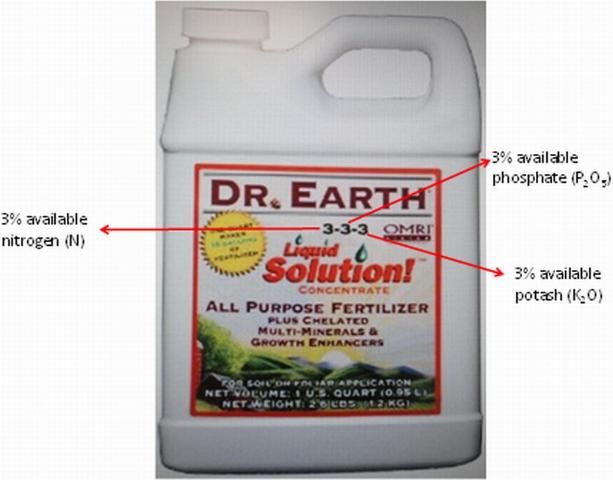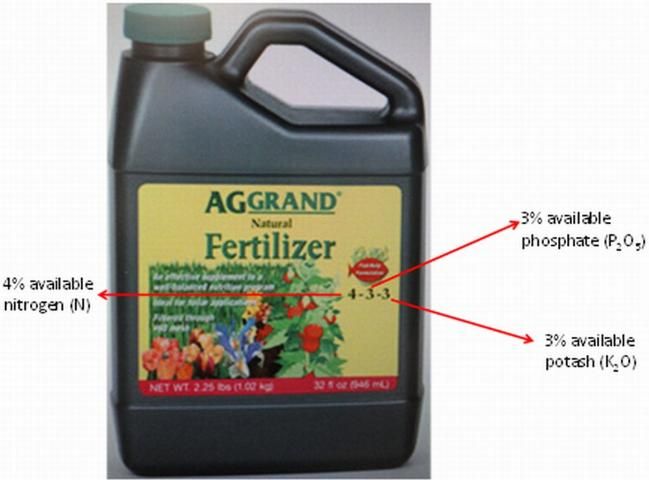Introduction
Dry and liquid fertilizers are widely used in crop production. In recent years, more and more liquid fertilizers have been used, particularly for fertigation, in vegetable and fruit production. Typically, UF/IFAS recommendations are expressed as pounds per acre, which can be converted to kilograms per hectare by multiplying by a factor of 1.12. Conversion either from a dry fertilizer basis (the UF/IFAS recommendation) to a liquid fertilizer basis, or from a liquid fertilizer source to the UF/IFAS recommended nutrient rate, is often required for a correct application rate. This publication helps growers understand the conversion method from liquid to dry fertilizer.
Why can this conversion be tricky?
Dry fertilizer and its active ingredients in fertilization are both gravimetric—in other words, expressed as a weight per area. For this type of fertilizer, the calculations are straight forward. For example, 100 pounds of a 10-10-10 fertilizer-grade material contains 10 pounds each of active ingredients, nitrogen (N), phosphorus (P2O5), and potassium (K2O), equaling 30 pounds total of active ingredients, while the remaining 70 pounds consist of inactive materials. Figures 1 through 4 provide examples of fertilizer bags or bottles for either dry or liquid fertilizers.

Credit: Guodong Liu, UF/IFAS

Credit: Guodong Liu, UF/IFAS

Credit: Guodong Liu, UF/IFAS

Credit: Guodong Liu, UF/IFAS
Liquid fertilizer active ingredients in fertilization are expressed on a volume basis. The density of the liquid fertilizer is a key detail because it is impossible to know the weight of a liquid fertilizer without knowing the density. Typically, the net volume and net weight are available on the liquid fertilizer label (Figure 3). The liquid density can be calculated based on these values. For example, on the Dr. Earth® label (Figure 3), its net volume is 0.946 liters (1 US quart), and its net weight is 1.2 kilograms (2.64 pounds). Therefore, its density is 1.27 kilograms per liter or 10.56 pounds per gallon (2.64 pounds/U.S. quart x 4 quarts/gallon). This source is a 3-3-3 liquid fertilizer. A quart of this liquid fertilizer contains 0.08 pounds (36 grams) each of N, P2O5, and K2O (0.24 pounds or 108 grams of N, P2O5, and K2O in total) and 2.4 pounds (1089 grams) of water or other inactive ingredients.
Liquid fertilizers differ in density. They are related in terms of active ingredients, but the density is NOT always proportional to the total active ingredients. For example, Dr. Earth® has a lower percentage of active ingredients but greater density than AgGrand®. Dr. Earth® has 9% active ingredients in total (3% each for N, P2O5, and K2O), and its density is 2.64 pounds per quart or 10.56 pounds per gallon (Figure 3). Its total active ingredients per quart are 0.24 pounds. AgGrand® (Figure 4) has a greater percentage (4% + 3% + 3% = 10%) of active ingredients in total but lower density (9.01 pounds per gallon) than Dr. Earth® (10.56 pounds per gallon). Therefore, the former has more active ingredients (0.24 pounds) than the latter (0.23 pounds). This indicates the importance of the density of liquid fertilizers in actual active ingredients. The most common error in conversion from liquid fertilizer to dry fertilizer is neglecting the density. In the above example, if the density of the fertilizers is neglected, crop plants treated with AgGrand® fertilizer may be getting less of each nutrient (N, P, and K) than those treated with Dr. Earth®.
How does one convert liquid fertilizer to dry fertilizer?
To determine how many gallons of a particular liquid fertilizer are needed per acre, use the following equation (Burt, O'Connor, and Ruehr 1995):

For example, the UF/IFAS recommendation for commercial tomato production in Florida is 200 pounds of N per acre. The injection rate would be 1.5–2.5 pounds per acre per day from 1 through 13 weeks after planting (Olson et al. 2012). For this example, assume 2 pounds per acre per day for a particular fertigation event and 10 acres to fertigate. Therefore, we need to use 20 pounds of N for the fertigation event. How many gallons of either of the above liquid fertilizers (Dr. Earth® or AgGrand®) are needed to supply 20 pounds of N to 10 acres?
(1) The 3-3-3 (Dr. Earth®) liquid fertilizer (fertilizer density: 10.56 pounds per gallon):


(2) The 4-3-3 (AgGrand®) liquid fertilizer (fertilizer density: 9.01 pounds per gallon):


AgGrand® has a greater N percentage than Dr. Earth®, so fewer gallons are needed to meet the 20 pounds of N requirement. Table 1 shows the calculation details for different acreage.
How many gallons of either of the above liquid fertilizers are needed to supply 20 pounds of P2O5 per 10 acres of tomato?
(1) The 3-3-3 (Dr. Earth®) liquid fertilizer (fertilizer density: 10.56 pounds per gallon):


(2) The 4-3-3 (AgGrand®) liquid fertilizer (fertilizer density: 9.01 pounds per gallon):


Both Dr. Earth® and AgGrand® have the same percentage of P2O5, but the former's liquid source has greater density, so fewer gallons are needed to supply 20 pounds P2O5 per 10 acres. Table 2 shows the calculation details for different scales of fertigation events.
For conversion factors of different units, such as from gallon to quart, from kilogram to pound, and from acre to hectare, please see Conversion Factors https://efotg.sc.egov.usda.gov/references/Delete/2017-1-21/Archived_Conversion_Factor_Tables_170118.pdf
Take-Home Message
- Dry fertilizer and its active ingredients in fertilization are both gravimetric—in other words, expressed as a weight per area.
- Liquid fertilizer and its active ingredients in fertilization are expressed on a volumetric basis—that is, as a volume per area.
- The key point for the conversion from liquid to dry fertilizer is the density of the liquid fertilizer.
- The greater the density of a liquid fertilizer, the more active ingredient volume. However, the active ingredients of a liquid fertilizer are NOT linearly proportional to the fertilizer's density.
- To avoid any errors, the conversion calculation from liquid to dry fertilizer must include the liquid fertilizer's density and active ingredient content.
References
Burt, C. M., K. O'Connor, and T. A. Ruehr. 1995. Fertigation. San Luis Obispo: Irrigation Training & Research Center.
Freeman, J. H., E. J. McAvoy, N. S. Boyd, R. Kanissery, H. A. Smith, J. Desaeger, G. E. Vallad, and P. B. Williams. 2021. Tomato Production in Florida. HS739. Gainesville: University of Florida Institute of Food and Agricultural Sciences. https://edis.ifas.ufl.edu/cv137. Accessed on February 5, 2024.
Calculations of liquid nitrogen (N) fertilizer requirement for different fertigation scales and fertilizers with various fertilizer densities.